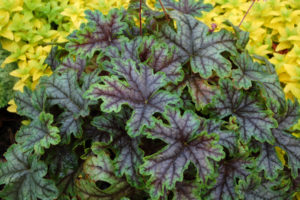Bloomers for the “In-Between” Stage
April 18th, 2017
Blooming cherry trees perfume the front yard, PJM rhododendrons light up the foundation beds, and daffodils and hyacinths carpet the walkway to the door.

It’s easy to hit a gap in early-season bloom unless you pay attention to what happens after the first bulbs bloom.
It’s a glorious start to another growing season, eh? Then all of a sudden… nothing.
Unless you’re paying attention to bloom times, it’s easy for your yard to hit a barren lull between the time the spring bulbs and early-blooming trees bloom and when the roses and annual flowers kick into high gear.
This “in-between zone” is a common occurrence in May and June as late spring hands off to early summer.
Not only is it an anticlimax during one of our nicest outdoor times of the year, it’s a serious drawback for those trying to attract bees, butterflies, birds and other pollinators into the landscape.
Pollinators can’t take 2 weeks off from eating or laying eggs. If you don’t supply what they need when they need it, they’ll go elsewhere – or won’t show up in your yard in the first place.
Unlike groundhogs and blight disease, dressing up the late-spring in-between zone is an easy problem to solve.
Lots of plants bloom in this time frame. Your job as gardener-in-chief is to know what they are and to take steps to include them into the yard. You can even plant most of them now – or at least make notes to add them on the back side of summer as temperatures cool again.
The quickest fix is to get annual flowers into the ground as soon as possible.
Most can’t tolerate frost (marigolds, zinnias, vinca, etc.), which means waiting until early May to mid-May to plant those.
However, a few annuals don’t mind chilly nights and can go in the ground now. These include pansies, violas, snapdragons, dusty miller, nemesia, cape daisies (Osteospermum) and annual dianthus.
Many of these are being bred for improved heat resistance, so the latest varieties get off to an early start but are less likely to fizzle at the first sign of 80 degrees. Even if they do, try cutting them back in mid-summer and watch for a comeback after Labor Day – or replace them in June with more heat-loving annuals.
Second, don’t write off bulbs as just March and April performers.
After popular early choices such as crocuses, Siberian squill, glory-of-the-snow, daffodils and hyacinths are spent, May becomes prime time for the short purple, blue or white spikes of grape hyacinths, later-blooming tulips (especially single and double lates, lily-flowered and fringe types, and green or ‘Viridiflora’ types), the bell-shaped blue blooms of Spanish bluebells (Hyacinthoides hispanica), and the striking gold, orange or red blooms of crown imperial (Fritillaria imperialis).

Allliums are perfect for color in the “in-between” spring time frame. This one is Allium christophii.
Best of all in this time frame is the ornamental onion or Allium family. Most of these bloom from late May into early June, including the purple softball-sized ‘Globemaster’ and ‘Gladiator’ varieties; Allium schubertii and A. christophii with their purple blooms that look like exploding planets, and “drumsticks” types (A. sphaerocephalon) with their bean-sized purple flowers atop stiff stems.
While many trees and shrubs take care of their flowering business between late March and early May, plenty of others are available to add interest from then until end of June.
Some good tree examples: the native American fringe tree (Chionanthus virginicus), which produces shaggy white flower clusters; the white bell-shaped flowers of Japanese snowbell (Styrax japonicus) and native Carolina silver bell (Halesia tetraptera); the native sweetbay magnolia (Magnolia virginiana) with its fragrant white flowers; the Japanese tree lilac (Syringa reticulata) with its fragrant June-blooming spikes, and the Kousa dogwood (Cornus kousa), an Oriental pink- or white-blooming tree that blooms weeks later than our native American dogwood.
Some good shrub examples: the native Virginia sweetspire (Itea virginica) with its arching bottle-brush flowers of white; Abelia x grandiflora and its white or pink trumpet flowers; the native ninebark (Physocarpus opulifolius) with its pinkish-white flower clusters, and shrub roses, which some years get busy blooming by late May and early June.
Your biggest ally in the in-between zone is the perennial section of the garden center.
You’ll find no shortage of late-May to June options there, ranging from sun-lovers such as salvias, bluestar (Amsonia), catmint, cranesbill (hardy geraniums), and iris to shade-preferrers such as barrenwort (Epimedium), fringe-leaf bleeding heart (Dicentra eximia), goats beard (Aruncus), lamium, and the beginning of astilbe bloom (go with the Chinese types for best heat resistance).
While you’re there, don’t overlook perennials with colorful foliage. These will add color to your gardens all season long, whether they’re blooming or not.
Some of the best examples are coral bells (Heuchera), foamflowers (Tiarella), foamybells (x Heucherella), false forget-me-nots (Brunnera macrophylla), hosta and Japanese forest grass (Hakonechloa macra).
Whenever your landscape has a down time, it makes sense to go to the garden center and see what’s blooming then. Ditto for paying a visit to a local public garden.
Those places will show you what your yard could look like and help you plan for that uninterrupted symphony of color that’ll make both you and the pollinators happy.
For more help, check out my list of What Blooms When in Central Pennsylvania.









